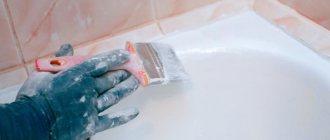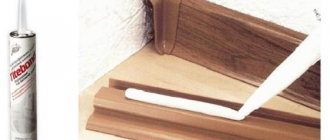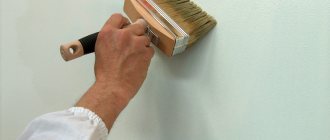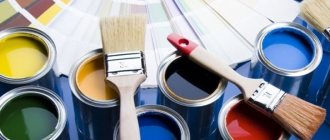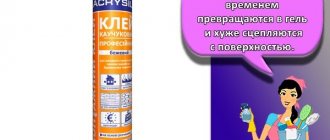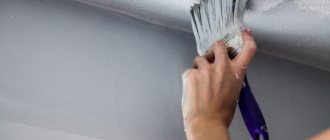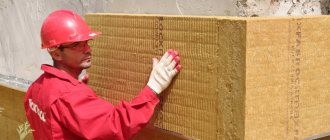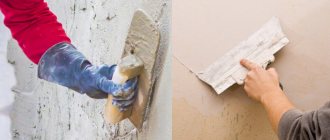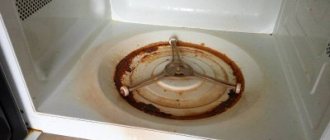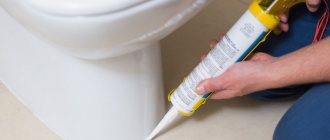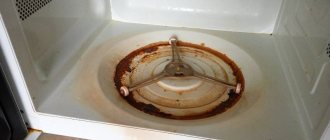What bath enamels are there?
Manufacturers offer different coatings for bathtub restoration. What requirements must be presented to the paint in order to choose the best option:
- Safety - bath enamel should not contain impurities that can be harmful to health;
- Thermal conductivity - the lower this indicator, the slower the water will cool, respectively, the longer and more comfortable it will be to splash around in the new bathtub;
- Durability - if your task is not to simply add shine, but to solve the problem with bathroom enamel for a long time, then the chosen enamel should be resistant to mechanical and chemical influences.
What enamels for bathroom renovations does the manufacturer offer, and which one is better:
- epoxy - epoxy paint has been used to restore bathtubs for more than two decades. It is a mixture of epoxy resin, fillers and pigments. Refers to two-component enamels that require dilution with a hardener before use;
- acrylic - latex paint, which is based on acrylic, has been conquering consumers for just over ten years. In terms of durability, it is not inferior to epoxy enamels. It is a representative of two-component paints. As a rule, acrylic uses a pouring technique to cover the bathtub;
- alkyd - these water-dispersed compositions do not contain solvents, so they are practically odorless. If the application technology is strictly followed, bath enamel will last about seven years.
Epoxy
Alkyd
Acrylic
Pros and cons of enameling
Restoring a bathtub with enamel is a difficult task, but profitable. For 5-7 years later, you can forget about chips, cracks, and scratches on the inner surface of the bowl. The price of enamel compositions is less than the cost of a new product.
Disadvantages of use:
- Lack of experience can significantly affect the result of the work. Therefore, it is important to watch the video and read articles before carrying out restoration work.
- Different types of enamels have an unpleasant, pungent odor, which is important to consider.
- A successful choice of bathroom coating is the key to successful work. One mistake, buying a coating for cast iron that a person will apply to acrylic will lead to unnecessary expenses.
Comparative characteristics of bath enamel
To determine which enamel is better, you need to know the pros and cons of each type, as well as how it is applied.
| Dye | pros | Minuses |
| Epoxy | Coating uniformity | Toxicity |
| Resistant to acids and alkalis | Once finished, the paint hardens very quickly. | |
| Does not erase | Possible leaks | |
| Suitable for metal and cast iron | Turns yellow quickly | |
| Acrylic | Maintains a presentable appearance for a long time | Acrylic is toxic |
| Resistance to mechanical damage | High consumption | |
| Low thermal conductivity | Do not use aggressive detergents | |
| Suitable for steel, cast iron, acrylic | Probability of detachment if technology is violated | |
| Alkyd | Non-toxic | Enameling requires careful surface preparation |
| Retains its original appearance for a long time | High consumption | |
| Suitable for all types of coating (including ceramics) | Difficulty of application |
What determines the quality of baths
The quality of an acrylic bathtub directly depends on the method of its manufacture and the thickness of the material. It is these criteria that are of paramount importance when choosing a model. For the production of bathtubs, two different technologies are used - extrusion and casting.
Acrylic bathtub design
The injection molding method makes it possible to produce a bowl of absolutely any size, thickness and configuration. The finished product is resistant to alkalis and acids, as well as mechanical damage. Another advantage is a perfectly smooth, dense surface, without pores or bumps. On such a surface, dirt does not accumulate, no traces of dyes remain, and mold does not develop. The disadvantages include the high cost due to the complexity of production, as well as the uneven thickness of the workpieces over the entire area.
Production of acrylic bathtubs
Making bathtubs from extruded acrylic involves molding multi-layer products using ABS plastic as a supporting base. This technology is characterized by higher productivity, which helps reduce the cost of products. In terms of impact resistance, as well as resistance to scratches and aggressive environments, they are only slightly inferior to injection molded ones, but their adhesion to the reinforcing layer is higher. Deviations from the nominal thickness of the bowl over the entire area are no more than 5%, which is very insignificant compared to injection molded models.
Production line
Both production methods are widely used by foreign and Russian companies, and provided that the technology is followed, the products produced are of very high quality
Unfortunately, many handicraft companies counterfeit both cast bathtubs and those made of extruded acrylic, so when choosing, special attention should be paid to the thickness of the material itself and the reinforcing layer
Related video: Production of acrylic bathtubs BAS
The thicker the acrylic sheet, the more reliable and durable the product. For cast acrylic, the optimal thickness is 4-6 mm, although in models on the market it varies between 2-8 mm, depending on the manufacturer. As practice shows, bathtubs with an acrylic layer 2-3 mm thick on average last up to 4 years, with a layer of 4-5 mm the service life will be about 7 years, with a layer of 6 mm - up to 10 years or more.
When planning to purchase a bathtub, take a flashlight with you. A poor-quality bathtub will be visible right through
It is important that the thickness of the acrylic along the entire length of the bath is the same
For bathtubs made of extruded material, the thickness of the acrylic coating should be in the range of 0.7-1 mm, while in cheap fakes it is only 0.2-0.3 mm. Such a bathtub will last a couple of years at most, then you will have to buy a new one. The thickness of the reinforcing layer in high-quality models is usually 4-5 mm, and the bottom and frame attachment points are additionally reinforced with chipboard.
High-quality bathtubs do not turn yellow or crack over time
Video on the topic: Production of acrylic bathtubs Aquatek
Ways to paint a bathtub
To restore bathtub enamel, three main methods are used and everyone decides for themselves which one is better:
- bulk;
- enamelling;
- aerosol.
The pour-in restoration method, at first glance, is one of the simplest. More often it is used to restore a cast iron bathtub. Acrylic is poured onto the sides of the bathtub. Liquid paint flows down, forming a new coating. The pouring technique allows you to correct unevenness, close cracks and make the surface perfectly smooth. But using acrylic without experience or minimal skills is quite problematic. Drips may form.
Pouring technique
Enameling involves using a brush or roller. This method is used to apply enamel and paint. Horizontal strokes alternate with vertical ones to avoid drips. Without waiting for the enamel to dry, apply the second and then subsequent layers.
Painting a bathtub with enamel
The aerosol method is really the simplest. Spray paint does not need to be pre-prepared. It is possible to immediately choose the appropriate color. Before use, shake the can well for two to three minutes.
Aerosol use
An alternative way to update your bathtub is to install an acrylic liner. Particularly suitable for restoring an old cast iron bathtub. This coating is installed using glue. The method is fast, simple and effective. The only difficulty is in caring for acrylic. He does not like aggressive cleaning agents and is sensitive to mechanical damage.
Acrylic liner
Review of popular enamels
Epoxin
To make it easier to choose a bath composition, it makes sense to consider the products of manufacturers that are in greatest demand. One such composition is Epoksin. It has an index marking 51 or 51C. The product has an affordable price, because it is produced by a domestic plant. At the same time, components for it are imported from Europe. The composition consists of two components that are mixed in the required proportions. The finished surface is resistant to chemicals containing chlorine and is therefore easy to clean. The service life of the bathtub after restoration reaches nine years, which is a good indicator.
This result can be achieved by following the technology described by the manufacturer. The correct proportions of the hardener will ensure that yellow spots do not appear on the surface. With Epoksin it is possible to use various pigments, which will allow the bath to fit into any interior. The composition copes well with small chips and potholes. But large flaws will need to be repaired with metal putty first. Enamel without index C can be diluted with solvents if necessary to change the consistency.
Note! Index C in the labeling indicates a reduction in polymerization time to a day, after which you can begin to fully use the bath.
Stakryl
“Stakryl” is a representative of the second type of enamels, which are based on acrylic. The raw materials for this enamel are also supplied from Europe. This composition belongs to the category of self-leveling baths, so its application does not cause any particular difficulties and practically does not require tools. One of the disadvantages is that the enamel almost completely repeats the structure of the surface of the bathtub, so it is better to putty it if there are significant flaws. The working time with the finished enamel solution is limited to 70 minutes. If you do not meet this deadline, the result will not please you.
Advice! When working with Stakryl, the use of personal protective equipment is mandatory. Not only the vapors are toxic, but also the composition itself, which can cause an allergic reaction if it comes into contact with the skin.
Preparatory work before applying this type of enamel to the bathtub is carried out in the same way as for the previous option. Since the composition of “Stacryl” and “Epoxin” is similar, the former can also be used in various colors, which give a special shade to the finished surface. Work on applying enamel must be carried out at the temperature recommended by the manufacturer. Otherwise, the viscosity of the composition will be too high and it will not be possible to apply it properly. The use of various solvents is not allowed, since the finishing surface will be uneven. The process of applying enamel to the bathtub is shown in the video below.
Random House
made sure that her product was convenient to use. The composition is also two-component, but the kit also includes liquids for degreasing the surface. Enamel with the name “Fantasy” makes it possible to obtain a snow-white surface, and “Svetlana” comes in a set with pastes to give a unique shade.
How to choose enamel
The coating to restore the bathtub to its former beauty is selected according to three criteria: application method, completeness and color. The application method - poured acrylic, aerosol or enamel - will depend on the degree of damage to the old enamel, the financial capabilities and skills of the artist. You can purchase all the necessary products separately. Some manufacturers produce bathroom enamel complete with a hardener, tinting paste, solvent and everything necessary for the preparation and process of refinishing the coating.
Using tinting paste, you can create any shade when restoring an old bathtub. It depends only on the taste, as well as the preferences of the owner. When purchasing two-component paint, you need to pay attention to the color of the hardener. A transparent, translucent or gray shade is better - the enamel component will not be noticeable after restoration. More saturated shades may leave spots and streaks.
Not only the final appearance, but also the durability and strength of the coating depends on the correct choice of enamel for bathtub restoration.
Preliminary work before applying enamel:
- a detergent (Pemolux) is applied and treated with an abrasive (grinder with a wheel, drill with an attachment, emery stone);
- treat with detergent to remove residual grease from cracks;
- rinse the bathtub with hot water for a long time;
- wipe with a clean rag;
- remove the siphon and overflow, clean the surface underneath;
- when the bath is dry, remove the residue with a vacuum cleaner (you can dry it with a hair dryer, but not with a hair dryer, because it can overheat the surface);
- application of enamel.
The drying process is 70 minutes.
Aerosol enamel, advantages and disadvantages
The aerosol technique is one of the easiest ways to update a bathtub. When choosing this option to revive the coating, you need to consider the pros and cons of such paint.
Advantages of spray paint:
- it dries quickly (a few hours is enough);
- no additional tools needed;
- aerosol enamel fits better on the surface and has good adhesion, that is, it adheres tightly;
- a varied assortment: cans can contain two-component paints, acrylic, and so on;
- easy application.
Bath enamel in a can
Disadvantages of aerosol enamels:
- difficult to use to restore large surfaces: certain skills are required to avoid uneven tone and drips;
- the layer turns out thin, since the composition of the aerosol paint includes a large percentage of solvent;
- fragility: a thin coating cannot guarantee a long service life of a new bathtub.
Using this technique, it is easy to restore an old cast-iron bathtub or make minor repairs to an acrylic bathtub.
Disadvantages of the method
The use of liquid acrylic does not always bring only benefits, because the material also has its disadvantages:
- Restoration technology must be carried out very strictly. At the slightest mistake, the coating will not be durable and will quickly become damaged;
- If such work is being carried out for the first time, then it is better to invite a specialist, at least for supervision and advice;
- Certain types of liquid acrylic contain toxic substances, so the work must be done in special clothing and rubber gloves;
- If there is sufficiently severe damage to the surface of the bathtub, then acrylic will not cope with it, and preliminary restoration will have to be carried out;
- The material takes a very long time to dry, it can even take 3-4 days;
- If liquid acrylic is applied incorrectly, it will be very difficult to remove it from the surface.
Types of aerosol paints
The modern market offers a large selection of aerosol enamels for baths and ceramics. Almost every manufacturer tries to produce bath paint in several formats, including aerosols or sprays.
Spray paint WHITEST New Ton
Aerosol New Ton is a Ukrainian epoxy-based bath enamel. The paint dries quickly and has excellent adhesion to enamel surfaces, which is especially necessary for restoration, for example, of an old cast-iron bathtub. The enamel is presented only in snow-white form. The volume of the can is 400 ml. Shelf life: 3 years. Cost – from 200 rubles per can.
It is important that New Ton provides a reliable coating with resistance to temperatures up to 100 degrees. The enamel does not peel off or crack. There is no need to prime the surface before applying New Ton. One layer dries in 6 hours, a completely multi-layer coating will dry in two days.
Enamel WHITEST New Ton
Enamel spray for baths and ceramics Kudo
Aerosol for baths and ceramics Kudo is a Russian alkyd-based enamel. Quick drying (no more than 5 hours), excellent adhesion to various materials made this paint very popular. Other positive qualities include temperature resistance and high hiding power. The shelf life is 5 years, and you will have to pay a little more than 200 rubles for a can.
Color – white – can volume 520 ml. This is enough to treat about 2 square meters of surface (in one layer). Dry for 10-15 minutes between coats. Complete drying of the treated surface is achieved after 24 hours. You can use the bath for its intended purpose after three days.
Enamel aerosol Kudo
Epoxy enamel DECORIX
DECORIX epoxy enamel made in China gives a snow-white glossy finish as a result of painting. The paint is resistant to mechanical damage (cracks, scratches), temperature changes, and fading. DECORIX enamel dries quickly and has good adhesion to various materials. The cost of a 520 ml can starts from 250 rubles.
Epoxy enamel DECORIX
Spray CHAMPION COLOR
CHAMPION COLOR is a Polish epoxy-based aerosol enamel. Suitable for various metals, ceramics, plastics. White color. The enamel has high gloss and good adhesion. The drying time of the layer is from one hour, while the manufacturer advises applying the enamel in a layer of 25 mm or more. After 72 hours, you can fully use the bath – the coating has completely dried and acquired all its properties. The shelf life is 5 years.
The volume of the can is 400 ml. This is enough to cover two square meters of area. Before use, shake the can about 30 times to thoroughly mix all the ingredients.
Spray CHAMPION COLOR
The first thing you need to do to understand whether you can get by with “little loss,” that is, with low material investments, is to assess the degree of wear and tear of the bathtub. If deep cracks or even chips appear on an enamel bathtub, then special work must be carried out. A bathtub is subject to restoration if:
- the enamel has turned yellow and faded;
- shallow cracks are noticeable;
- the coating became loose.
Throw it away or re-enamel it? If you are still asking yourself this question, weigh the pros and cons. Replacing a bathtub will require significant financial investment and is more appropriate in the case of a major renovation. Spray enamel can easily cope with small cracks and loss of shine. It does not need to be prepared, diluted with a hardener, solvent or color. Applying a completely finished product will save effort and money. In a few hours, the most worn-out cast iron bathtub will shine with its pristine beauty.
Annoying mistakes: what to watch out for
Independent work on updating a bathtub with liquid acrylic requires not only adherence to a certain technology
It is also important to avoid making gross mistakes that will ruin all your efforts. Moreover, knowing about the features of the material itself and not having practical experience working with it, it is quite easy to miss something important. In the future, such small nuances will quickly render the recently restored enamel unusable.
It may begin to flake and peel off the surface of the bathtub.
In the future, such small nuances will quickly render the recently restored enamel unusable. It may begin to flake and peel off the surface of the bathtub.
The main mistakes made during restoration work:
- buying a fake instead of liquid acrylic;
- incorrect mixing of components;
- poor surface preparation;
- moisture residues in hard-to-reach places;
- unsuitable temperature conditions;
- ingress of dust and other inclusions;
- early operation of the restored capacity.
The undoubted advantage of self-leveling acrylic is that it is able to cope with the restoration of absolutely any bathtub - both small and huge. The main thing is to buy enough material
Unscrupulous sellers, in order to profit from inexperienced consumers, offer expensive acrylic made in Finland, Germany or Slovenia. In fact, these countries have not heard anything about the products supposedly produced in them.
Another mistake is incorrectly mixed ingredients. To avoid such an annoying misunderstanding, you need to carefully read the manufacturer’s instructions and only then begin to follow them to the letter.
Instructions and useful recommendations from the material manufacturer are usually printed on the back of the can of acrylic enamel, which is to be mixed with the hardener.
If you prepare the surface of a restored bathtub “at random”, ignoring the recommendations of experienced craftsmen, the result will be disastrous. Within a month, bubbles will appear and the gloss will peel off, revealing the dull outlines of the old container.
Water remaining in some places will ruin the entire work. The fact is that liquid acrylic will peel off from a wet surface.
All work must be carried out at a temperature not exceeding 25°C. Otherwise, the drying process of the material can significantly speed up, which is especially sad for the home craftsman. An experienced specialist, having assessed the temperature in the room, will act in accordance with it.
The ingress of dust, drops of water, lint from towels and other foreign objects onto the wet surface of the restored enamel will ruin its appearance. Trying to correct such a nuisance can make the situation even worse. It is better not to use the room at all until the surface is completely dry.
If the restoration is done correctly, then the old bathtub is absolutely indistinguishable from the new one. She is beautiful, shiny and snow-white
Knowing about all these mistakes, you can try to avoid them. Then the work will be done with high quality, and the updated plumbing will delight you with its ideal smoothness and long service life.
The subtleties of repairing cast iron bathtubs are given in the following article. It describes in detail the technology for restoring plumbing fixtures and provides useful recommendations.
Tips and recommendations for use
When using such a paint coating, it is recommended to follow certain advice from experts. Let's consider the main recommendations when using the composition:
- before applying to the surface, it is necessary to properly prepare and degrease the metal before painting;
- It is imperative to thoroughly shake the can of paint so that the composition is thoroughly mixed;
- It is necessary to use a respirator when working, as the composition is highly toxic and has a strong odor;
- during the spraying process, it is necessary to immediately eliminate all possible enamel stains so that they do not have time to harden;
- The entire coating should be applied in even layers, while waiting until it dries completely.
Taking into account all these recommendations, it is possible to create a correct and high-quality coating of the enamel layer when restoring a metal bathtub from certain defects and other mechanical damage.
Important. Immediately before work, the structure is completely dried, and in addition, all traces of corrosion and other deposits present are removed from it.
Restoration with liquid acrylic
As the name implies, the main component of the restoration in this case is liquid acrylic. Because it is not applied to the surface of the bathtub with a brush, but rather acrylic is actually poured over the walls, this method is also known as a “pour-in bathtub.”
Technology
As in the previous case, the restoration process with liquid acrylic consists of two stages: preparing the bath and applying acrylic.
If the preparation stage is practically no different from the process described above, then the application of acrylic itself has certain features.
After the astringent component is added to the liquid acrylic (it is supplied along with the material itself), the acrylic is applied to the bathtub walls not with a brush, but by pouring. Simply put, the solution is simply poured from a small container along the edges of the bath, allowing it to flow inside. After which the acrylic is evenly distributed over the entire surface using a special rubber spatula.
Advantages and disadvantages
Restoring a bathtub using self-leveling acrylic is relatively inexpensive, which can undoubtedly be considered one of the advantages of this method. But unlike painting, self-leveling acrylic stays on the surface of the bathtub much longer; moreover, if scratches or chips form on it, they can be easily removed using inexpensive “repair kits.”
And another undoubted advantage of liquid acrylic is a wide selection of colors.
The disadvantages of this method can be considered a rather specific technology for applying acrylic, which, despite its apparent simplicity, a person without experience may not be able to cope with. In addition, acrylic takes quite a long time to dry, so after application you can use the bathtub no earlier than 3-4 days later.
Conclusion: restoration with poured acrylic can be called the “golden mean”. On the one hand, it is relatively inexpensive, and on the other hand, it allows you to get quite acceptable results. In addition, in some cases, for example, when it comes to “non-standard” bathtubs, poured acrylic is the only method of restoration.
Video: bathtub restoration with liquid acrylic
In order to clearly get acquainted with the “fill-in bath” technology, we present to your attention a short video.
https://youtube.com/watch?v=DMTFU_Tbid8
All recovery methods at home
There are several different methods to restore your bathtub to its pleasant appearance.
Restoration with poured acrylic
Restoration using self-leveling acrylic is becoming increasingly popular, since this material is very affordable and easy to use. Restoring enamel using this method includes several stages. Necessary:
- Prepare the surface.
- Pour the mixture into the bath in a thin stream (it distributes itself, so no additional manipulations are necessary).
- Wait until the bath is completely dry (this will take about 2 days, but it is not advisable to open the windows, this will dry the composition faster).
Do-it-yourself restoration of bathtubs with liquid acrylic is quite inexpensive (although the cost of the material is slightly higher than that of enamel compositions) and at the same time the simplest and most affordable method that does not require much effort. For such a restoration, you do not need to purchase any additional tools; you only need a small container from which you can pour the composition.
Restoration with poured acrylic is the easiest and most affordable way
Video: restoring a bathtub with liquid acrylic
How to restore a cast iron bathtub with enamel
Of all the methods for restoring a cast-iron bathtub, painting with enamel is most suitable, although the method can also be used for acrylic structures. In order to restore the surface of the product, it is necessary:
- Prepare the bath.
- Prepare the enamel composition according to the instructions, mix it thoroughly to get rid of lumps and achieve a uniform consistency.
- Using a brush, apply the first layer, carefully and thoroughly painting all areas.
- Dry the bath thoroughly, and then proceed to apply the next layer (a total of 3 or more will be needed, depending on the initial state of the structure). Each layer dries for about 24 hours at room temperature.
This restoration method is the most budget-friendly, but it requires a lot of time and effort.
To restore the surface, the application of enamel composition in several layers is required.
Restoration using an acrylic liner
To restore a bathtub with an acrylic liner, you must choose it correctly. To do this, evaluate parameters such as the shape, dimensions of the structure (they must perfectly match the size and shape of the bath), its thickness and color.
The work is carried out in the following sequence:
- Preparing the liner (it is tried on the structure, after which the protruding parts are removed using a jigsaw, a hole for the drain is marked and it is drilled).
- Treating the drainage area and the edge of the structure with sealant.
- Applying special foam to the entire surface of the bath, carefully distributing it.
- Installation of the prepared liner into the bathtub by pressing it firmly to the surface.
- Replacing the siphon (if desired, so that the bath really looks like new).
This restoration method is expensive and time-consuming, but it is most suitable for acrylic bathtubs that have severe damage (chips and deep cracks).
Installing an acrylic liner is a labor-intensive process
